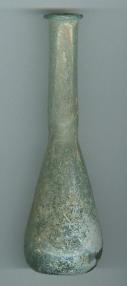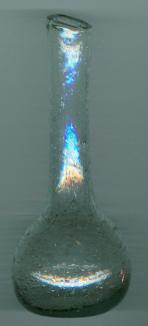
 The Roman period saw the invention of glass blowing around 100 A.D. This new
technology allowed thousands of glass bottles to be produced and made bottles
more accessible for medicine and perfumes. The tear-drop shape was easily
produced and quickly became a common style. More information on
apothecary bottles can be found at the
New Zealand Glass Museum.
The Roman period saw the invention of glass blowing around 100 A.D. This new
technology allowed thousands of glass bottles to be produced and made bottles
more accessible for medicine and perfumes. The tear-drop shape was easily
produced and quickly became a common style. More information on
apothecary bottles can be found at the
New Zealand Glass Museum.
 The confirmed use of bottles during this period by apothecaries lends
credibility to the argument that lachrymatory were actually never used to
capture tears. The problem with this argument is the reference to capturing
tears in the Bible. Regardless of the version or interpretation, it is clear
that the concept of capturing tears existing in the popular culture of the time.
The confirmed use of bottles during this period by apothecaries lends
credibility to the argument that lachrymatory were actually never used to
capture tears. The problem with this argument is the reference to capturing
tears in the Bible. Regardless of the version or interpretation, it is clear
that the concept of capturing tears existing in the popular culture of the time.
Roman lachrymatory are available through a variety of antiquities dealers and
auction houses. More info on these pieces can be found in the
collecting section.
Interestingly, the art of glass blowing was largely lost, along with many
other things, during the Dark Ages. An interesting perspective on why the Dark
Ages began is offered by Professor Mike Baillie on ABC News. Unfortunately, the tear bottle tradition was also
lost for a millennium.
